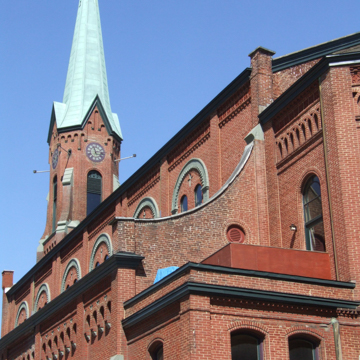You are here
Angel's Arms Condominiums
This complex of Romanesque Revival buildings served the parish of St. Michael's (now part of Prince of Peace parish) on the slopes above the South Side. The first church of 1848 was demolished a decade later to make room for the current St. Michael's, designed by Charles F. Bartberger and completed in 1861. It is a stern and handsome red brick German-style Romanesque Revival building with a tall square entrance tower. Several impressive support buildings added over the decades include the rectory at the corner of Pius and Clinton streets (1889, Frederick C. Sauer), several school buildings, and a parish house known as the “Casino.” All are in variants of the Romanesque Revival idiom. In the early twenty-first century, almost everything in this complex, church included, was turned into condominiums, though exterior changes were minimal.
The oldest surviving building of the group, higher still on Mount Washington, is Bartberger's St. Paul of the Cross Monastery (143 Monastery Street) of 1853, again in Romanesque Revival. This Passionist priory served the German immigrant workers who erected the hundreds of tiny frame houses that cover the hillside. The complex also includes St. Michael's Cemetery on S. 18th Street, at the brow of Mount Washington. This windswept slope is Pittsburgh industrial melancholy at its best. The gravestones, mainly chiseled in German, are evocative, but unforgettable is the view across the Monongahela River into Oakland, the Bluff, and the Golden Triangle. On a slope too daunting to be turned to industrial profit, the skilled German craft workers rest in the harshness of their adopted land.
Writing Credits
If SAH Archipedia has been useful to you, please consider supporting it.
SAH Archipedia tells the story of the United States through its buildings, landscapes, and cities. This freely available resource empowers the public with authoritative knowledge that deepens their understanding and appreciation of the built environment. But the Society of Architectural Historians, which created SAH Archipedia with University of Virginia Press, needs your support to maintain the high-caliber research, writing, photography, cartography, editing, design, and programming that make SAH Archipedia a trusted online resource available to all who value the history of place, heritage tourism, and learning.





















